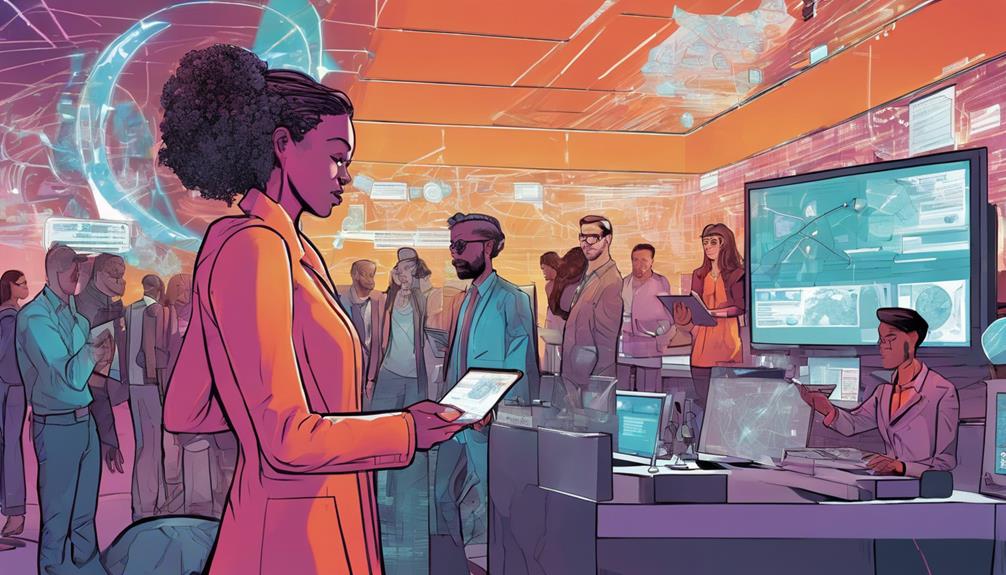You're entering a pivotal moment in customer experience, where understanding engagement and leveraging technology are key. By tapping into data analytics, you can tailor interactions and predict customer needs. Personalization fosters loyalty, making customers feel valued. Engaging directly through phone outreach or targeted promotions enhances satisfaction and drives loyalty. As you embrace these strategies, focus on building genuine relationships for lasting connections. The future is not just about transactions; it's about creating memorable experiences. Discovering how to implement these strategies effectively can elevate your approach to customer experience even further.
Key Takeaways
- Personalized communication driven by data analytics enhances customer experiences and builds long-term loyalty.
- Predictive analytics anticipate customer needs, leading to tailored interactions and increased satisfaction.
- Proactive engagement strategies, such as targeted offers and follow-ups, address immediate customer concerns effectively.
- Leveraging technology like AI streamlines operations and personalizes marketing efforts for better audience connection.
Understanding Customer Engagement
Customer engagement is all about connecting with your audience in meaningful ways that drive satisfaction and loyalty.
To truly engage your customers, you need to understand their preferences and behaviors. This means actively listening to their feedback and responding to their needs.
Personalized communication can enhance their experience, making them feel valued and understood. Use data analytics to tailor your interactions, ensuring that you're meeting their expectations at every touchpoint.
Regularly assess your engagement strategies, adjusting them based on customer insights. Remember, it's not just about selling; it's about building relationships.
When you prioritize genuine connections, your customers are more likely to remain loyal and advocate for your brand, creating a thriving community around your business.
Next Best Action Strategies

To enhance engagement, implementing Next Best Action strategies allows you to identify the most effective steps for connecting with your audience.
By focusing on immediate needs, you can tailor your approach for maximum impact.
Consider these actions:
- Phone Outreach: Directly engage with customers to address their concerns.
- Coupon Distribution: Offer targeted discounts that resonate with specific segments.
- Personalized Recommendations: Suggest products based on previous purchases.
- Follow-Up Emails: Keep the conversation going with timely check-ins.
Personalization Through Predictive Analytics

Harnessing the power of predictive analytics transforms how businesses personalize interactions, making them more relevant and timely for you.
By analyzing your data, companies can anticipate your needs and preferences, leading to tailored experiences that enhance your satisfaction. This approach not only identifies what you're likely to purchase next but also suggests offers and products that genuinely interest you.
Imagine receiving personalized recommendations that align perfectly with your past purchases or preferences, making your shopping experience smoother and more enjoyable.
As businesses utilize AI and machine learning to refine these insights, you benefit from a deeper connection and engagement, ultimately increasing your likelihood of returning for future interactions.
Personalization through predictive analytics is reshaping customer experiences for the better.
Enhancing Customer Satisfaction Metrics

Predictive analytics not only personalizes your shopping experience but also plays a significant role in enhancing customer satisfaction metrics by providing insights that drive continuous improvement.
By leveraging data, you can focus on key areas that boost customer happiness:
- Targeted Offers: Create personalized promotions that resonate with individual preferences.
- Feedback Analysis: Use customer feedback to identify pain points and address them promptly.
- Proactive Engagement: Anticipate customer needs and reach out before they've to ask.
- Performance Tracking: Regularly monitor satisfaction scores to adjust strategies in real-time.
Youth Entrepreneurship and Innovation

Youth entrepreneurship thrives on innovation, fueling creativity and ambition among the next generation of business leaders.
You'll find that young entrepreneurs aren't just dreamers; they're doers, harnessing technology and fresh ideas to tackle real-world challenges.
They're reshaping industries by leveraging digital platforms and social media to reach wider audiences.
By focusing on sustainability and social impact, you can create businesses that resonate with today's consumers.
Engaging with educational resources and mentorship programs will help you develop essential skills and connect with like-minded peers.
This vibrant entrepreneurial spirit encourages you to take calculated risks, adapt quickly, and continuously innovate.
Embrace your potential, and you'll contribute to a future where customer experience is defined by creativity and responsiveness.
Superstitions Impacting Performance

Superstitions can greatly influence your performance, providing a psychological edge that boosts confidence in high-pressure situations.
Whether you believe in them or not, these rituals can help you focus and feel more prepared.
Consider some common superstitions that athletes and performers use:
- Lucky socks – Wearing the same pair for every game or performance.
- Pre-game rituals – Engaging in specific routines before competition.
- Avoiding certain numbers – Steering clear of unlucky digits when making decisions.
- Carrying talismans – Using charms or objects believed to bring good luck.
These practices may seem trivial, but they can enhance your mindset, making you more resilient and focused when it matters most.
Embrace the power of belief, and see how it can elevate your performance.
Small Business Trends for 2024

As you explore how psychological factors like superstitions can influence performance, consider that 2024 brings a wealth of opportunities for small businesses to capitalize on emerging trends and consumer demands.
You'll want to focus on eco-friendly products and services, as sustainability continues to resonate with consumers.
Personalized marketing strategies will help you connect more effectively with your audience, making them feel valued.
Additionally, embracing technology like AI can streamline operations and enhance customer experiences.
The rise of remote work creates a demand for home-based businesses, so think about how you can meet that need.
Finally, consider subscription models; they offer steady revenue and foster customer loyalty.
Adapting to these trends will position your small business for success.
Navigating Tech Career Opportunities

Steering through tech career opportunities can be both exciting and challenging, especially with the industry's rapid evolution and competitive landscape. To successfully navigate this terrain, you'll want to focus on key strategies:
- Network Actively: Connect with industry professionals through events and online platforms.
- Tailor Your Resume: Customize it to highlight relevant skills and experiences for each application.
- Stay Updated: Keep abreast of the latest trends and technologies relevant to your field.
- Develop Soft Skills: Communication and teamwork are just as important as technical abilities.
Conclusion
As you stand at the crossroads of innovation and tradition, remember that the future of customer experience lies in your hands.
Embrace the power of advanced analytics alongside the personal touch of genuine engagement. While technology offers speed and efficiency, it's your ability to connect emotionally that cultivates loyalty.
By balancing data-driven strategies with heartfelt interactions, you can transform fleeting moments into lasting memories, ensuring your brand not only survives but thrives in this dynamic landscape.









